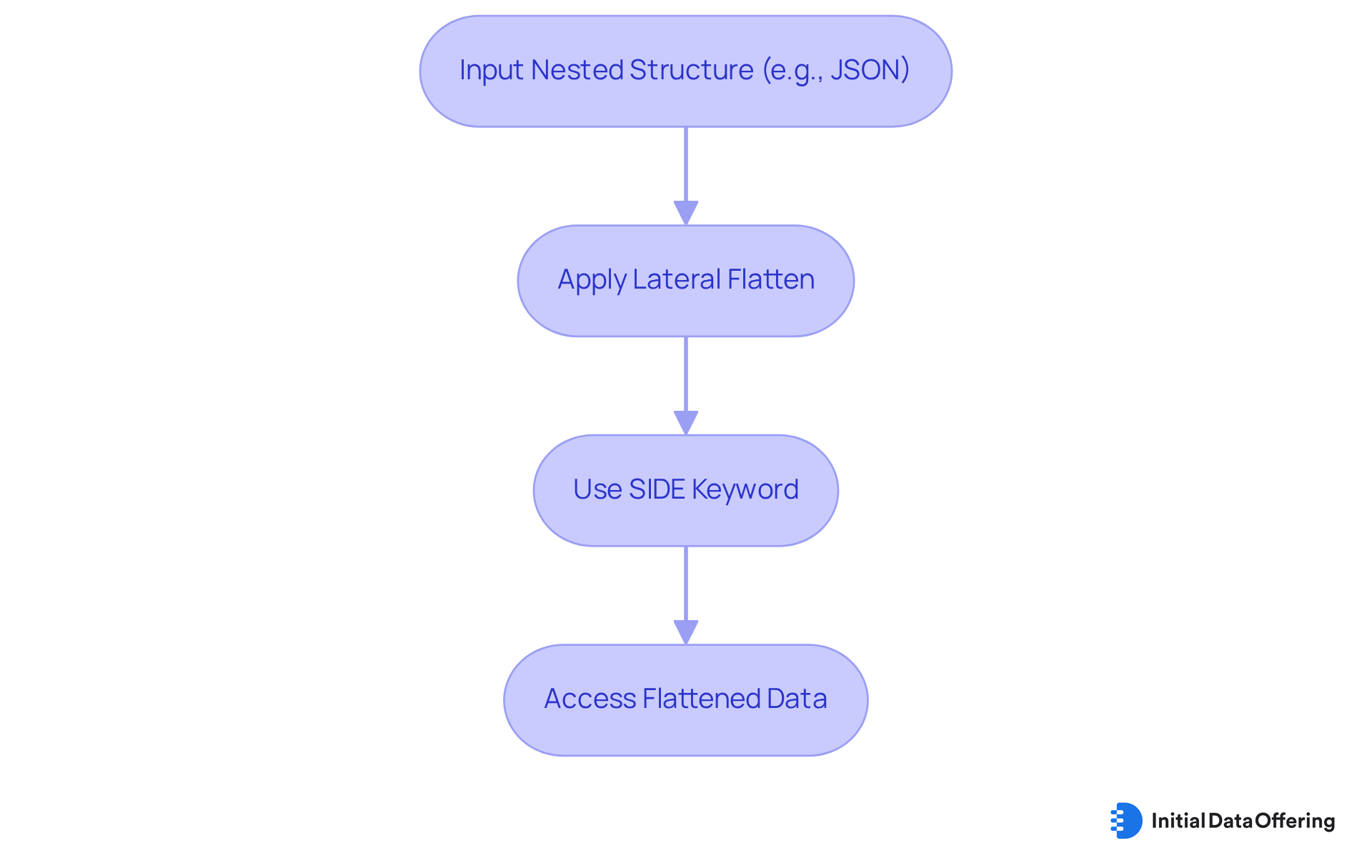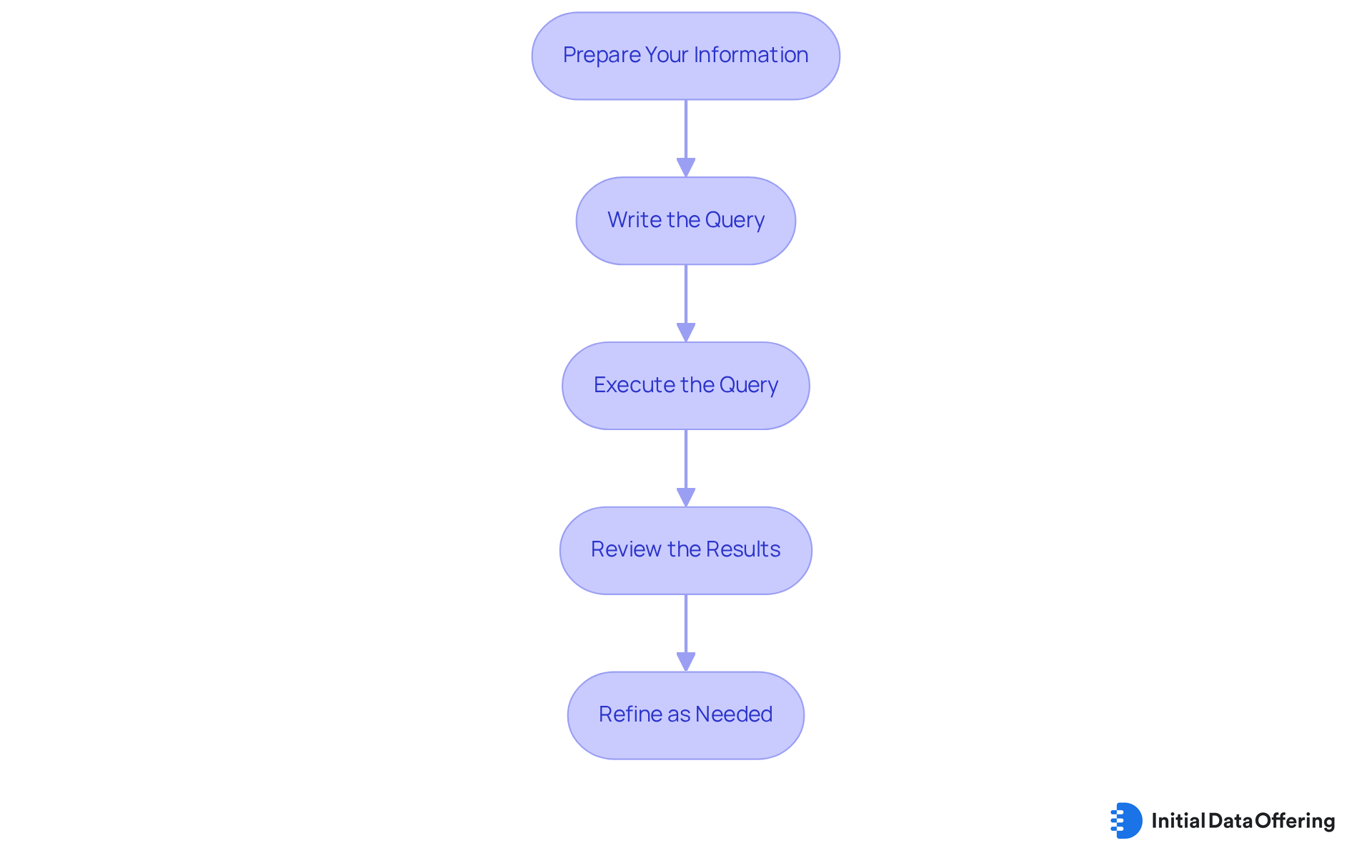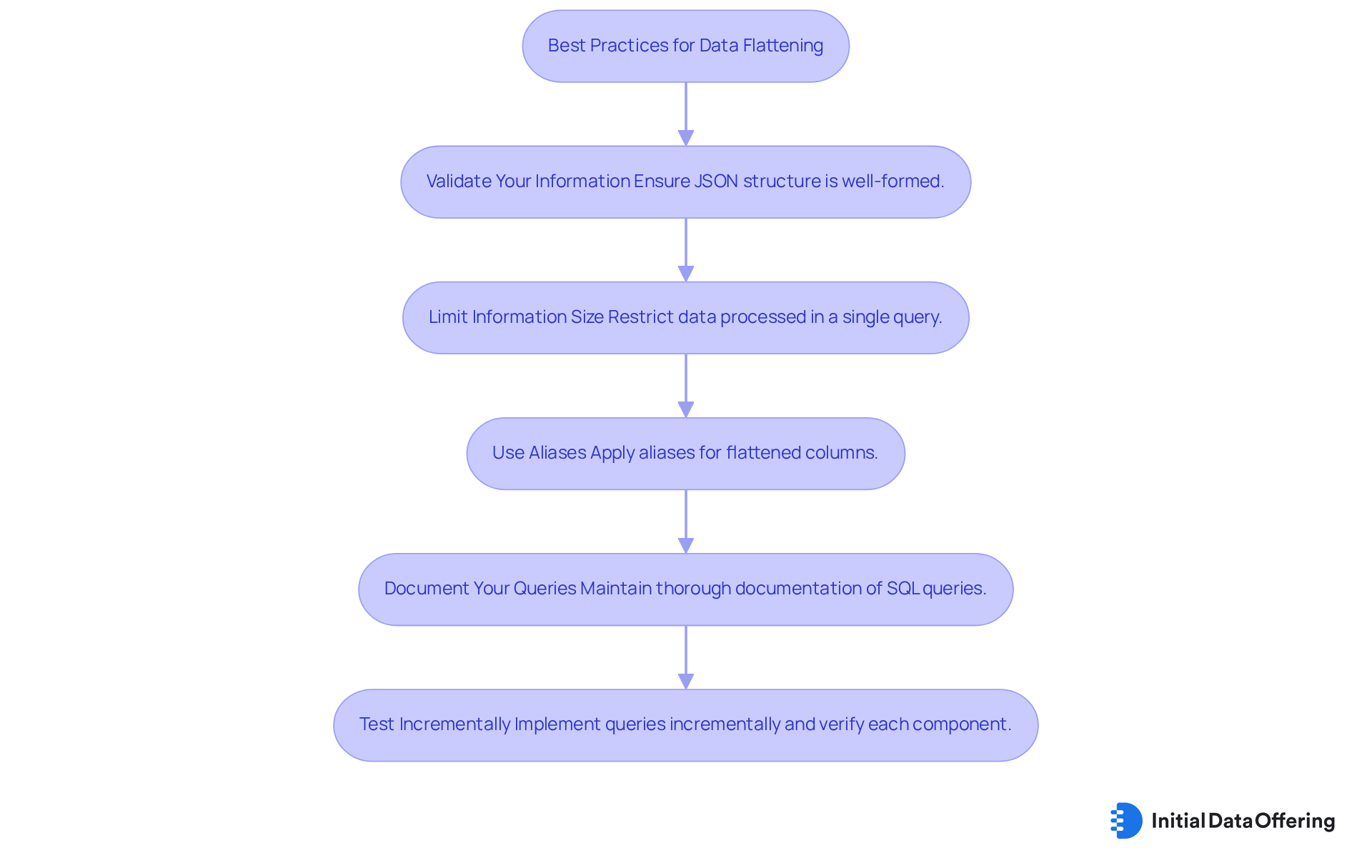Master Lateral Flatten Snowflake: Step-by-Step Implementation

Master Lateral Flatten Snowflake: Step-by-Step Implementation
Overview
The article presents a comprehensive guide on implementing the LATERAL FLATTEN function in Snowflake. It details step-by-step instructions for transforming nested JSON structures into a flat, tabular format. This process not only enhances data handling practices but also enables more efficient access and analysis of complex datasets.
The article emphasizes structured preparation, query execution, and best practices for managing common challenges, such as null values and performance issues. By following these guidelines, readers can improve their data management strategies and facilitate better decision-making.
Introduction
Navigating the complexities of data management often requires innovative solutions, particularly when addressing nested structures like JSON. The LATERAL FLATTEN function in Snowflake stands out as a powerful tool, designed to transform intricate datasets into a more manageable, flat format. By mastering this functionality, users can streamline their data workflows, uncovering valuable insights hidden within semi-structured information.
However, what challenges might arise during implementation? How can users effectively overcome these obstacles to optimize their data analysis processes? Understanding these aspects is crucial for harnessing the full potential of data management.
Understand Lateral Flatten in Snowflake
A robust table procedure in Snowflake allows users to transform nested structures, such as JSON arrays or objects, into a flat, tabular format. This feature is particularly advantageous when dealing with semi-structured data, as it enables users to access and analyze information more efficiently. The SIDE keyword enhances this process by enabling the EXPAND function to reference columns from earlier tables, facilitating the dynamic extraction of values from nested structures.
Understanding how Snowflake transformation functions is crucial for anyone aiming to effectively manage intricate datasets in Snowflake.
How can this capability improve your data handling practices? By leveraging these features, users can streamline their workflows and derive actionable insights from complex datasets.

Implement Lateral Flatten: Step-by-Step Instructions
To effectively implement LATERAL FLATTEN in Snowflake, follow these structured steps:
-
Prepare Your Information: Begin with a table that includes a VARIANT, OBJECT, or ARRAY column containing nested content. It is essential to ensure that your JSON information is well-formed before ingestion to avoid issues later. For example, create a table named
my_tablewith a columndatathat holds JSON data:CREATE OR REPLACE TABLE my_table (data VARIANT); INSERT INTO my_table VALUES (PARSE_JSON('{"name": "John", "hobbies": ["reading", "gaming"]}')); -
Write the Query: Utilize the lateral expand function in your SQL query to extract the nested information. Here’s an example query:
SELECT value AS hobby FROM my_table, LATERAL FLATTEN(input => data:hobbies); -
Execute the Query: Run the query in your Snowflake environment. This action will produce a flat list of hobbies extracted from the JSON information, providing clear insights into the data.
-
Review the Results: Carefully examine the output to confirm that the information has been flattened correctly, with each hobby displayed in a separate row. This step ensures the accuracy of your data extraction.
-
Refine as Needed: Depending on your data structure, you may need to modify the path in the flattening process to target specific nested elements. Consider using the OUTER parameter to include rows that cannot be expanded, which generates NULL values for zero-row expansions.
Common Challenges
Users often encounter challenges such as handling NULL values and performance issues with large datasets when implementing LATERAL FLATTEN. To mitigate these, consider using COALESCE or IFNULL functions to manage NULLs effectively, which can enhance the reliability of your queries.
Best Practices
For optimal results, ensure your JSON data is well-formed before ingestion. Furthermore, utilizing the RECURSIVE parameter can assist in expanding deeply nested structures, thus improving your analysis capabilities and facilitating deeper insights into your data.
Recent Tutorials
Stay updated with recent tutorials that explore advanced uses of LATERAL FLATTEN, including techniques for optimizing query performance and managing complex data structures. This ongoing learning can significantly enhance your proficiency in data analysis.
Case Studies
Case studies demonstrate the successful application of LATERAL FLATTEN in various scenarios, showcasing how organizations have improved their data analysis processes by leveraging this powerful function. These real-world examples can inspire and guide your own implementations.

Troubleshoot Common Issues with Lateral Flatten
When utilizing lateral flatten in Snowflake, users may encounter that can impact the effectiveness of data manipulation.
-
Null Values: Nested information containing null values can lead to unexpected outcomes from the transformation function. To effectively manage this, filter out nulls in your query:
SELECT value AS hobby FROM my_table, LATERAL FLATTEN(input => data:hobbies) WHERE value IS NOT NULL;By addressing null values, you ensure more accurate results in .
-
Performance Issues: Flattening extensive datasets may result in performance degradation. For instance, implementing an incremental flattening strategy can reduce parse time from about 15 minutes to under 3 minutes. To enhance efficiency, ensure your queries are optimized and consider processing smaller segments at a time. This approach not only improves performance but also streamlines your workflow.
-
Incorrect Path References: If the path indicated in the transformation does not correspond with your JSON structure, it may yield no results. It is crucial to check the path to ensure it accurately reflects your information's hierarchy, thereby preventing potential data loss.
-
Unclear Column Names: Utilizing several expansion methods can result in ambiguous column names. To maintain clarity in your results, apply aliases to your columns:
SELECT value AS hobby1, value2 AS hobby2 FROM my_table, LATERAL FLATTEN(input => data:hobbies) AS f1, LATERAL FLATTEN(input => data:other_hobbies) AS f2;This practice enhances the readability of your results, making data interpretation more straightforward.
-
Data Validation: Ensure your JSON structure is well-formed before ingestion by utilizing methods such as TRY_PARSE_JSON. This step is crucial to avoid errors during analysis, ensuring data integrity and reliability.
By addressing these typical challenges, users can enhance their utilization of the horizontal function, ensuring more precise and efficient information manipulation. Expert insights, including those from Nikesh Vora, underscore that flattening JSON structures transforms nested formats into a tabular arrangement. This conversion provides significant advantages, such as simplified querying and enhanced performance, ultimately benefiting .
Adopt Best Practices for Effective Data Flattening
To maximize the effectiveness of LATERAL FLATTEN in Snowflake, it is essential to adhere to several best practices:
- Validate Your Information: Ensure that your is well-formed prior to ingestion into Snowflake. Utilizing validation tools for JSON structure can prevent complications during the flattening process. As industry experts emphasize, being data-driven is crucial for effective analysis, making validation a key step.
- Limit Information Size: When managing extensive datasets, it is advisable to restrict the amount of information processed in a single query. Flattening all homes can take upwards of 15 minutes for each run; thus, this strategy not only enhances performance but also minimizes the likelihood of errors, akin to how a lateral flatten snowflake creates a more even structure.
- Use Aliases: Always apply aliases for your flattened columns to maintain clarity, especially when executing multiple FLATTEN operations within a single query. This practice helps avoid confusion and keeps your queries organized.
- Document Your Queries: Maintain thorough documentation of your SQL queries, particularly those involving complex structures. This practice assists both you and your team in understanding the rationale behind your information manipulations, thereby fostering a collaborative environment.
- Test Incrementally: Implement new queries incrementally, verifying that each component functions correctly before integrating them into larger queries. This method aids in isolating potential issues and simplifies troubleshooting, ensuring that your data processes remain efficient and effective.

Conclusion
Mastering the LATERAL FLATTEN function in Snowflake is essential for anyone looking to efficiently manage and analyze complex datasets. This powerful tool transforms nested structures into a flat, tabular format, enabling users to extract valuable insights from semi-structured data with ease. By implementing LATERAL FLATTEN, users can streamline their workflows and enhance their data analysis capabilities, ultimately leading to better decision-making.
The article outlines a comprehensive step-by-step guide for implementing LATERAL FLATTEN, starting from preparing the data to executing queries and troubleshooting common issues. Key practices such as:
- Validating JSON structures
- Managing NULL values
- Utilizing aliases for clarity
are emphasized to ensure effective data manipulation. Additionally, the article highlights the importance of adopting best practices to optimize performance and enhance the reliability of queries.
In conclusion, leveraging the LATERAL FLATTEN feature in Snowflake can significantly improve data handling practices, allowing for clearer insights and more efficient analysis. By following the outlined steps and best practices, users can navigate the complexities of nested data structures, ultimately transforming their approach to data analysis. Embracing these techniques not only fosters a deeper understanding of data but also empowers organizations to make data-driven decisions that can drive success.
Frequently Asked Questions
What is Lateral Flatten in Snowflake?
Lateral Flatten is a robust table procedure in Snowflake that allows users to transform nested structures, such as JSON arrays or objects, into a flat, tabular format.
Why is Lateral Flatten useful for handling semi-structured data?
It enables users to access and analyze information more efficiently by converting complex nested structures into a more manageable flat format.
What role does the SIDE keyword play in the Lateral Flatten process?
The SIDE keyword enhances the process by allowing the EXPAND function to reference columns from earlier tables, which facilitates the dynamic extraction of values from nested structures.
Why is it important to understand Lateral Flatten transformation functions?
Understanding these functions is crucial for effectively managing intricate datasets in Snowflake and improving data handling practices.
How can leveraging Lateral Flatten features improve workflows?
By using these features, users can streamline their workflows and derive actionable insights from complex datasets.